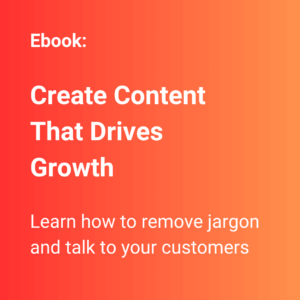Your content is supposed to drive growth.
Good content builds trust, attract leads, open doors, shorten sales cycles.
But for a lot of SaaS and B2B companies, it just… doesn’t.
Even with consistent output, solid SEO, and a capable team, the content doesn’t convert.
It’s not a strategy problem. It’s not a format problem.
It’s a messaging problem.
Because if you can’t explain what you do in a way that’s clear, specific, and relevant to your audience, no amount of content will make an impact.
Here’s the good news: once you fix your messaging, your content starts doing what it’s supposed to do—drive results.
This guide will help you start speaking to your audience clearly—and in a way that sells
💡 When your messaging makes you the smart choice, everything gets easier: Faster sales. More clarity. Stronger positioning. Less second-guessing.
🧠 Most B2B and SaaS companies produce content that's polished—but says very little. It blends in. It confuses. It gets ignored.
Today’s buyer doesn’t read for fun. They’re busy, overloaded, and skeptical. You have seconds to show:
- You understand their world
- You’re solving a real problem
- You can explain it clearly
If your content doesn’t hit those marks, it doesn’t matter how good your product is.
That’s why great messaging isn’t a nice-to-have—it’s a multiplier.
It makes every campaign, asset, and conversation more effective.
🧠 Messaging is a system. Garbage in, garbage out.
The Jargon Trap: What’s Getting in Your Way
Most weak messaging falls into the same trap: jargon.
It sounds smart… but it kills clarity.
Here are the four usual suspects:
- Corporate speak: “Leverage,” “synergy,” “bandwidth,” “agile”
- Buzzwords: “Next-gen,” “best-in-class,” “seamless,” “revolutionary”
- Internal lingo: Your team’s made-up phrases that outsiders don’t get
- Deep tech talk: Complex, niche terms that alienate non-technical buyers
This kind of language doesn’t build trust. It puts a wall between you and the people you’re trying to reach.
How Do You Write Messaging That Actually Works?
If you want your content to drive results, you need messaging that’s clear, specific, and built around real human value. Here’s how to shift:
1. Remove it
Start by cutting the clutter. If a word doesn’t add meaning or clarity, it’s out.
✂️ Goodbye “outcome-based strategies.” You won’t be missed.
2. Swap it
Replace jargon with language that’s simple and direct.
“Empower accelerated synergies” becomes “help your team finish projects faster.”
3. Picture it
Help your reader visualize success.
Instead of “leverage next-gen tech,” try “ditch the spreadsheets and focus on customers.”
4. Shorten it
Fancy isn’t better. Long words = low clarity.
Change “capabilities” to “tools.” Swap “utilize” for “use.”
Step-by-Step: How Your Company Can Go Jargon-Free
Here’s how to move from unclear messaging to sharp, growth-driving content—without chaos or confusion.
✅ Step 1: Audit your current messaging
Start with your homepage, one-pagers, and campaign assets. Highlight any:
→ Vague claims (“innovative,” “transformative”)
→ Internal phrases no one outside your company would understand
→ Tech-heavy explanations in your top-level messaging
→ Use this as your “jargon hit list.”
✅ Step 2: Define your value, clearly
For each product or service, write down:
→ Who it’s for (target customer or buyer)
→ What it helps them do (job to be done)
→ What pain it solves
→ What makes it different or better
If your team can’t answer these clearly, fix that before writing a single word.
✅ Step 3: Rewrite for humans
Take your jargon-heavy copy and apply the four messaging shifts explained above:
→ Remove
→ Swap
→ Picture
→ Shorten
Ask: Would a smart person outside our company understand this instantly?
If not, go simpler.
✅ Step 4: Pressure-test with real people
Share your revised messaging with:
→ A few sales team members
→ A customer success manager
→ Someone not in your industry
Ask what stood out, what confused them, and what felt clear. Adjust accordingly.
✅ Step 5: Train the team
Even the clearest messaging will drift if everyone’s not on board.
Run a short training or workshop to:
→ Show why clarity matters
→ Explain your messaging do’s and don’ts
→ Share examples of good and bad copy
→ Set expectations for consistency
✅ Step 6: Embed it everywhere
Roll your updated messaging into:
→ Website and landing pages
→ Sales decks and outreach
→ Paid campaigns and content marketing
→ Internal onboarding and brand docs
Make it the new standard—not just a one-off rewrite.
Real-World Makeovers: Jargon vs. Clarity
Before:
“Measure what matters and lead strategic growth with next-gen data insights.”
After:
“Find your best buyers, engage them, and finally get credit for the revenue your team drives.”
Before:
“Unleash the power of 5G with a best-of-breed, multigenerational network infrastructure.”
After:
“Move fast with 5G while keeping the value of your 3G and 4G networks.”
Clear messaging doesn’t just sound better—it performs better.
💡 If a prospect walks away and remembers just one thing—what should it be?
That’s your One Key Message (OKM). Everything else is built around that.
Remember: You're Not Just Talking to Techies
In SaaS and B2B, decisions are made by buying groups.
According to Gartner, that’s usually 6 to 10 people. Most of them? Not technical.
If your content only speaks to engineers or IT leads, you’re losing decision-makers who care about outcomes, not acronyms.
The Old Way
What Your Product Enables
The Gain
Understanding the Voice of Your Customer
- Gather raw input from interviews, sales calls, support chats, reviews
- Identify core pains, hesitations, decision drivers
- Group and theme the findings
- Build a swipe file of “sticky copy”—phrases that are sharp, emotional, or reframe value in a new way
👉 Voice of customer isn't about parroting—it's about translating.
The best messaging is disciplined. Every sentence has a job. Every section has one clear takeaway.
“We’re the fastest, most efficient, and safest…”
Nothing.


